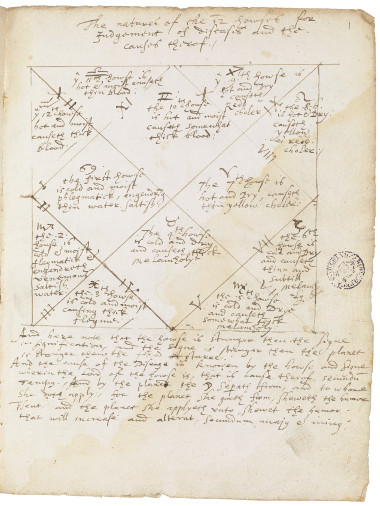Introduction to the edition of The Astrologicalle Judgmentes of phisick and other Questions

MS Ashmole 363, f. 1r. Copyright Bodleian Library, University of Oxford, 2018.
From 1606 until some point between late 1609 and late 1611, Simon Forman composed a guide to astrology, ‘The Astrologicalle Judgmentes of phisick and other Questions’. This presented Forman’s explanation of his astrological practice and was compiled using excerpts from books he had read and what he referred to as ‘our experience’. It is punctuated with worked examples from his casebooks. Although it was clearly prepared for dissemination, its structure is occasionally inconsistent and it may have remained unfinished or been partially revised. Several guides to astrology written by Forman survive; the one presented here was begun on 16 September 1606 according to the work’s full title given in MS Ashmole 389, and it contains examples from the casebooks dating from as late as 1609. It offers an important insight into the casebooks of Forman and Napier (who learned the system from Forman) detailing, for instance, a typical consultation; the information they demanded from querents; and the features found in astrological figures and their significance. It illuminates Forman’s approach towards both his practice and his clients, and a technical context for understanding what the two astrologers recorded, what they decided, and why.
The work is intended for an astrologically literate reader, assuming an understanding of astrology and its technical vocabulary. It is devoted principally to a detailed study of the significance of the different regions of the astrological figure and the constellations and planets circling it. After an initial discussion of the significance of who was asking the question, the work is divided into twelve sections, each dealing with one of the twelve ‘houses’ of the astrological chart. A particular house might have significance for particular parts of the body, the illness and its cure, and the process of consultation itself: if a parent asked the astrologer about a sick child, the astrologer should concentrate on the fifth house, which could also in the right circumstances represent the liver, the ‘matrix’ (womb) and menstruation. The sixth house, on the other hand, provided an indication of what the illness was, its past and future course, its causes, and whether it was curable or if it would get better or worse. Moving through these houses, the signs of the zodiac also had particular significances: Aries, according to a figure at the beginning of the work, is ‘hote and drie engendreth thin yellow collor’, while Virgo is ‘Cold and drie engendreth melancoly som what thick’. Lastly, the planets had particular natures and significations, depending on where they were in the chart, in which signs and houses and in relation to each other. Mastering the complex relationships between these factors allowed the astrologer to come to a judgment about the patient’s problem and how it might be best dealt with.
We learn from Forman’s guide that the information to be gained was not restricted to answering what the querent asked, or to identifying the patient’s problem. It was also possible for the practitioner himself to find advice in the astrological figure. Analysing the figure could tell the practitioner ‘the time to administer to the sick’; it could give him information on whether ‘the partie hath taken Any phisick or Medison all redy or noe or wher [i.e. whether] phisick wilbe good for them or noe’. More narrowly focusing on the practitioner’s own interest, the figure could even reveal whether it was ‘Best to tak one in hand to Cuer him of his dizease or noe’, and at another point Forman details how studying the second house ‘showethe/ what profite and Commoditie, the phisisyon shal have by the sick person, And wher the Sick will pay him wel or noe’. Every aspect of the relationship between the querent and the practitioner was represented in the chart, as well as the state of the patient and the likely outcome of the disease.
Besides the medical, Forman provided instructions on topics ranging from finding a thief to the possibility of success in alchemy. Chapters and passages from the ‘Astrologicalle Judgmentes’ explain how one might find out ‘Of A shipp. wher she be taken or noe’; what to do ‘To Knowe where [i.e. whether] a man shall obtaine that dignitie or effecte, that he desireth or secketh whether it be Knighthood or Lordshipe or Bishopericke’; and sections bear titles such as ‘De Thesauro Abscondito’ (on hidden treasure), and ‘Howe many husbandes A woman shal have’.
Forman’s guides to astrology

The title page of one of Forman’s guides to astrology, ‘The Astrologicalle Judgmentes of phisick…’ (MS Ashmole 389). Copyright Bodleian Library, University of Oxford, 2018.
Forman’s ‘Astrologicalle Judgmentes’ was the most substantial of a series of books that he wrote through the 1590s and 1600s to instruct novice astrologers in his methods. These guides to astrology, and the related guides to geomancy, are a perfect source for historians to understand the ways in which the casebooks were constructed. They were never printed. Copies survive along with the rest of Forman’s manuscripts, and there is some evidence that they circulated in this format.
Forman was building on a long tradition of astrological manuals, some devoted in part or in full to astrological medicine. Most of these were large Latin treatises, circulating in printed editions. A handful of English books was printed in Elizabethan London, more often translations from the French than freshly authored texts. Forman’s astrological guides were the most substantial English manuals of this sort until William Lilly’s Christian astrology was published in 1647.
Manuals of astrological physic
- ‘The grounds of arte gathered out of diverse authors’, 1594–5, Bodleian Library, Oxford, MS Ashmole 1495
- ‘Liber juditiorum morborum’ (‘Book of the judgments of diseases’), 1600, MS Ashmole 355; an exact copy by Thomas Robson, MS Ashmole 1411
- ‘The astrologicalle judgmentes of phisick and other questions’ (this is discussed in more detail below) Version one, c. 1596–1601, copied by Richard Napier, Gerence James, Mr Willoughby and an unidentified associate of Napier’s, MS Ashmole 403 Version two, 1600 with later additions, copied by three scribes, possibly including Thomas Robson, MS Ashmole 363 Version three, 1606 with later additions, Forman’s hand, MS Ashmole 389 Partial copy of version two, British Library, London, MS Sloane 99.
- New discovery! ‘Of the 12 Signs what partes of man’s body they have and what dyseazes they cause’, c. 1598–1603, MS Ashmole 395. This work was identified as Forman’s by Lauren Kassell in 2007. It has not featured in studies of Forman to date.
Guides to geomancy
- ‘De arte geomantica’ (‘Of the geomantic art’), 1589, MS Ashmole 354
- Another treatise on geomancy, c. 1590, revised c. 1611, MS Ashmole 392
The Astrologicalle Judgmentes of phisick and other Questions: witnesses and dating
Forman wrote at least two versions of ‘The Astrologicalle Judgmentes of phisick and other Questions’.
The earliest extant version of the text, surviving in MS Ashmole 403, was underway from 1596: on folio 81v Forman refers to ‘the yeere 1596 in which yeere I Simon Forman Compiled this booke out of all my bookes of experience’. While the largest number of examples are from 1596 itself, however, there are some from the years 1598–1601; it is not clear whether Forman worked on it throughout the period 1596–1601, or if he completed the text largely in 1596 then supplemented it afterwards with these later examples. The copy that survives was produced for Richard Napier, largely by Gerence James and Mr Willoughby with a few folios by an unidentified assistant of Napier’s; Willoughby appears in Napier’s casebooks intermittently from 1605 to 1618, but the unidentified scribe’s hand can be found in entries between 1628 and 1630.
The edition of The Astrologicalle Judgmentes of phisick and other Questions presented here is of a slightly later version, based on two substantially complete witnesses and an additional partial witness.
This text, which survives in MS Ashmole 389 and MS Ashmole 363, was begun on 16 September 1606 according to the work’s full title as given in Ashmole 389: ‘THE Astrologicalle Judgmentes of phisick and other Questions writen by Simon forman Dr of Astronomy and Phisick 1606 Lambeth the 16 of September. In which is Comprised his Experience for 20 yeares before And many yeares after.’ The examples used in this version include one or two from an earlier period than Ashmole 403’s (1583–1584), then a large number from later dates running up to 1609. Ashmole 389 is in Forman’s own hand, and must therefore have been completed some time between 1609 and Forman’s death in September 1611. Ashmole 363 is a neat copy produced by three scribes.
Because Ashmole 389 is in Forman’s hand, where its text and that of Ashmole 363 differ, 389 can usually be taken as the more authoritative version. In the edition, the readings and spellings from 389 are preferred where they do not include an evident mistake. This witness is, however, incomplete; several passages present in Ashmole 363 are missing from 389.
Ashmole 363 seems to be substantially complete, but a high number of copying errors, misreadings and misunderstandings mean that care must be taken with this witness. On the whole, points at which 363 diverges from 389 have been treated as variations and not corrected except where an error has resulted in nonsense. Although in general the readings in Ashmole 389 have been preferred, a number of significant gaps in that text have been supplied using Ashmole 363. A further difficulty is that in two places Ashmole 363 jumps backwards and repeats several pages, leaving us with duplicated passages; for the purposes of encoding this edition these overlapping passages have been treated as separate (partial) witnesses.
The edition also incorporates a very short excerpt copied by Napier, bound into one of his casebooks: MS Ashmole 174 (vol. 55).
The work is presented here in two versions, a normalised text and a diplomatic text. The normalised version silently expands abbreviated words, includes additions and removes deletions, and includes minor corrections; it also simply presents the text without noting variant readings, though it does indicate points at which a manuscript other than MS Ashmole 389 is being taken as the source. The diplomatic version presents an uncorrected text with additions and deletions marked as such and brevigraphs unexpanded; in places where the witnesses differ substantively, all the substantive variations are presented — differences of spelling or punctuation are not displayed in order to prevent the text from becoming unreadable.
Read The Astrologicalle Judgmentes of phisick and other Questions. Please note if using your browser’s ‘Find’ function to search or navigate within the text that the spellings are not standardised and are in many cases inconsistent.
Richard Napier’s preface to Forman’s ‘Astrologicalle judgmentes’
To accompany Forman’s guide to astrology, Napier wrote a preface entitled ‘A treatise touching the Defence of Astrology’. We do not know its date of composition, but in a letter of September 1599 Forman reminded Napier of his promise to compose it, and on 29 May 1602 Napier recorded having sent ‘my apology of Astrology to Mr Doctor forman’. Its purpose, as Forman put it, was ‘the Aunsweringe of All Invectives Against our profession’. It is uncertain whether Napier ever completed the work, and neither it, nor the work by Forman which it was to accompany, was ever published. It survives only in an autograph draft covered in additions, deletions and reworkings, which has since been divided between two manuscripts in the Ashmole collection and lacks some pages (MS Ashmole 204, ff. 50–63 and MS Ashmole 242, ff. 187r–195v); and an incomplete neat copy in two hands that ends midway through (MS Ashmole 242, ff. 187r–196r).
Although the treatise is incomplete, its broad themes are clear from the fragments that survive. Napier referred in its opening line to judicial astrology’s ‘antiquity’, its ‘pleasure’ and its ‘necessity or commoditie’, and in the pages that follow he discussed each of these in turn.
Citing ancient authors, he traced the art back to the patriarchs, who (he explained) had it from God and passed it on to their children. He demonstrated the pleasure of studying the heavens by listing those philosophers who praised it, and those emperors who made time for it in amongst the business of government, or who paid astrologers for public teaching. Lastly he confronted the ‘profit’ of astrology, its utility for husbandry, navigation, medicine, law and divinity. From offering a way to determine the best times to sign contracts or administer medicines, to helping predict storms and trace the seasons of growing crops, this was astrology more narrowly conceived – the predicting of the heavens’ effects, not just their study.
He quoted philosophers and theologians from all eras in support of the fundamental contention that the heavens, moved by God, in turn influenced and caused change in things on the earth; that the stars and planets were the means by which God caused natural events. Napier also noted the clear effects of the sun as it moved through the constellations of the zodiac, warming the earth and allowing it to cool again, driving the seasons, giving rise to growth and decay by turn. The rule exercised by the heavens over living bodies meant (he argued) that astrology was essential to the proper conduct of physic. Anyone who practised medicine without knowing astrology might prove not only useless, but actively harmful.
In the later parts of what survives, Napier attempted to deflect biblical and patristic criticisms of astrology by distinguishing a permitted form of judicial astrology that could make predictions within certain bounds. Future events that depended on human will could not be predicted; on the other hand, probable guesses could be made for events that arose largely from natural causes but that might nevertheless be diverted by someone exercising free will. Health and sickness, or the length of someone’s life, fell into this category: a judicial astrologer could legitimately predict these things, but someone whose behaviour was guided by reason and virtue rather than by bodily appetite might evade the influences of the heavens and meet a different fate. An astrology that paid attention to its limitations, that allowed for free will, was permissible and profitable; an astrology that did not, and that claimed to predict everything, therefore denied free will — and it was this that the bible and the church fathers had attacked when they denounced astrology.
(See Lauren Kassell, Medicine and Magic in Elizabethan London (2005), pp. 60–65 and 68–70, on Napier’s treatise and its relation to Forman’s guide.)
- ‘A treatise touching the Defenc of Astrologie’, Napier’s draft, MS Ashmole 204, ff. 50–63; cont. MS Ashmole 240, ff. 137–138
- ‘A treatise touching the Defence of Astrology’, incomplete transcription, MS Ashmole 242, ff. 187–196


